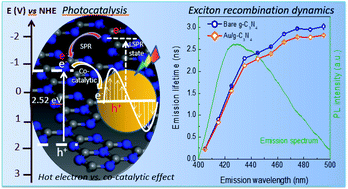Wavelength dependent luminescence decay kinetics in ‘quantum-confined’ g-C3N4 nanosheets exhibiting high photocatalytic efficiency upon plasmonic coupling†
Abstract
Serendipitous observations offer newer insights into materials properties. Here we describe g-C3N4 nanosheets exhibiting remarkably blue-shifted photoluminescence within the 390–580 nm range centred at 425 nm which matches more closely with its ‘quantum-dots’, and yet is excitation-wavelength independent. Moreover, surprisingly, the luminescence decay becomes increasingly slow at higher emission wavelengths, by up to 10 times. The nanosheets absorb only a fraction of visible-light. To improve this, when we designed a nanocomposite of g-C3N4 and Au nanoparticles (NPs), it retained the PL characteristics and also exhibited excellent light-harvesting and photocatalytic efficiency for benzylamine (BA) oxidation. The surface plasmon resonance of the Au NPs is responsible for the high visible-light response and assisting the reaction by the ‘hot-electron’ injection mechanism, while an uncharacteristic, pronounced co-catalytic effect by them further improves the efficiency. The conversion is 98% with >99% selectivity over 1.5 h of natural sunlight and open-air, probably the highest efficiency for BA photo-oxidation reactions. Even though such a dual role by plasmonic NPs has remained unscrutinized, we argue that the charge-transfer processes for the ‘hot-carrier’ injection and co-catalytic events are well-separated in time due to a much slower photon incident frequency on a catalyst particle, enabling both to occur simultaneously in the same particle.



 Please wait while we load your content...
Please wait while we load your content...